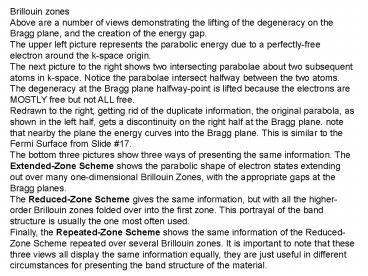Brillouin zones - PowerPoint PPT Presentation
1 / 20
Title:
Brillouin zones
Description:
Above are a number of views demonstrating the lifting of the degeneracy on the ... The upper left picture represents the parabolic energy due to a perfectly-free ... – PowerPoint PPT presentation
Number of Views:771
Avg rating:3.0/5.0
Title: Brillouin zones
1
Brillouin zones Above are a number of views
demonstrating the lifting of the degeneracy on
the Bragg plane, and the creation of the energy
gap. The upper left picture represents the
parabolic energy due to a perfectly-free electron
around the k-space origin. The next picture to
the right shows two intersecting parabolae about
two subsequent atoms in k-space. Notice the
parabolae intersect halfway between the two
atoms. The degeneracy at the Bragg plane
halfway-point is lifted because the electrons are
MOSTLY free but not ALL free. Redrawn to the
right, getting rid of the duplicate information,
the original parabola, as shown in the left half,
gets a discontinuity on the right half at the
Bragg plane. note that nearby the plane the
energy curves into the Bragg plane. This is
similar to the Fermi Surface from Slide 17. The
bottom three pictures show three ways of
presenting the same information. The
Extended-Zone Scheme shows the parabolic shape of
electron states extending out over many
one-dimensional Brillouin Zones, with the
appropriate gaps at the Bragg planes. The
Reduced-Zone Scheme gives the same information,
but with all the higher-order Brillouin zones
folded over into the first zone. This portrayal
of the band structure is usually the one most
often used. Finally, the Repeated-Zone Scheme
shows the same information of the Reduced-Zone
Scheme repeated over several Brillouin zones. It
is important to note that these three views all
display the same information equally, they are
just useful in different circumstances for
presenting the band structure of the material.
2
(No Transcript)
3
(No Transcript)
4
(No Transcript)
5
(No Transcript)
6
(No Transcript)
7
(No Transcript)
8
(No Transcript)
9
- Ionic Conductivity
- This property is very important because the
production of oxygen depends on the oxygen-ion
conductivity of the ceramic sample. Dopants may
affect the ionic conductivity. This one is
measured thanks to a four-point probe method at
several temperature between 500 and 1000 C. This
test measures the flow of electrons which is
proportional to the flow of oxygen ions. This
test is relatively easy to realize, so it allows
for a comparison of many samples. However, it is
not possible to separate ionic conductivity from
electronic conductivity. After a first selection
of samples, oxygen production tests will be
performed, such as the Solid Oxide Electrolyte
Cell Test, to check that only conduction in
samples is only ionic.
10
(No Transcript)
11
(No Transcript)
12
(No Transcript)
13
(No Transcript)
14
(No Transcript)
15
(No Transcript)
16
(No Transcript)
17
(No Transcript)
18
(No Transcript)
19
(No Transcript)
20
(No Transcript)































